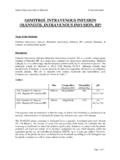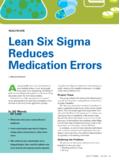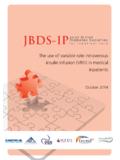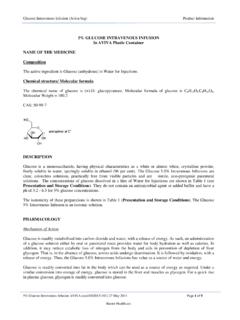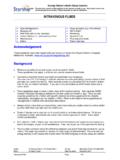Transcription of VENTOLIN INJECTION & SOLUTION FOR …
1 1 DATA SHEET VENTOLIN INJECTION VENTOLIN SOLUTION for intravenous Infusion Salbutamol INJECTION and salbutamol SOLUTION for intravenous INJECTION 500 g/mL, 1mg/mL. Qualitative and quantitative composition VENTOLIN INJECTION 500 g ( ) in 1mL (500 g/ml) is presented in ampoules of 1mL each containing Salbutamol BP as Salbutamol Sulphate BP, in a sterile isotonic SOLUTION adjusted to pH with sulphuric acid. VENTOLIN SOLUTION FOR intravenous INFUSION 5mg in 5mL (1mg/mL) is presented as ampoules of 5mL each containing 5mg Salbutamol BP as Salbutamol Sulphate BP, in a sterile isotonic SOLUTION adjusted to pH with sulphuric acid. The ampoules are of clear, neutral glass and the SOLUTION is colourless or faintly straw coloured. Clinical particulars Therapeutic indications Respiratory Salbutamol is a selective 2 adrenoceptor agonist indicated for the treatment or prevention of bronchospasm.
2 It provides short acting bronchodilation in reversible airways obstruction due to asthma, chronic bronchitis and emphysema. Bronchodilators should not be the only or main treatment in patients with persistent asthma. In patients with persistent asthma unresponsive to salbutamol, treatment with inhaled corticosteroids is recommended to achieve and maintain control. Failing to respond to treatment with salbutamol may signal a need for urgent medical advice or treatment. Relief of severe bronchospasm associated with asthma or bronchitis and for the treatment of status asthmaticus. 2 Management of premature labour Salbutamol is a selective 2 adrenoceptor agonist. At therapeutic doses it acts on the 2 adrenoceptors in the uterus, with little or no action on the -1 adrenoceptors of the heart.
3 For the management of uncomplicated premature labour between 22 and 37 weeks of gestation in patients with no medical or obstetric contraindication to tocolytic therapy. Treatment should not be continued for more than 48 hours. Posology and method of administration Salbutamol has a duration of action of 4 to 6 hours in most patients. VENTOLIN parenteral preparations are to be used under the direction of a physician. Increasing use of 2 agonists may be a sign of worsening asthma. Under these conditions a reassessment of the patient's therapy plan may be required and concomitant glucocorticosteroid therapy should be considered. Note: The contents of the ampoules of VENTOLIN SOLUTION for intravenous Infusion must not be injected undiluted. The concentration should be reduced by 50% before administration.
4 VENTOLIN parenteral preparations should not be administered in the same syringe or infusion as any other medication. Adults:- In severe bronchospasm and status asthmaticus: Subcutaneous Route:- 500 g (8 g/kg bodyweight) and repeated every 4 hours as required. Intramuscular Route:- 500 g (8 g/kg bodyweight) and repeated every 4 hours as required. intravenous Route:- 250 g (4 g/kg bodyweight) injected slowly. If necessary the dose may be repeated. VENTOLIN INJECTION 250 g in 5mL (50 g/mL) is a suitably dilute preparation for slow intravenous INJECTION but if VENTOLIN INJECTION 500 g in 1mL (500 g/mL) is used the INJECTION may be facilitated by dilution with water for injections. 3 Infusion:- In status asthmaticus, infusion rates of 3 to 20 g per minute are generally adequate but in patients with respiratory failure, higher dosage has been used with success.
5 A starting dose of 5 g per minute is recommended with appropriate adjustment in dosage according to patient response. A suitable SOLUTION for infusion may be prepared by diluting 5mL of VENTOLIN SOLUTION for intravenous Infusion in 500mL of an infusion SOLUTION such as sodium chloride and dextrose INJECTION BP to provide a salbutamol dose of 10 g/mL of SOLUTION . In the management of premature labour: Treatment with VENTOLIN INJECTION / SOLUTION for intravenous Infusion should only be initiated by obstetricians/physicians experienced in the use of tocolytic agents. Ideally, it should be carried out in facilities adequately equipped to perform continuous monitoring of maternal and foetal health status. Duration of treatment should not exceed 48 hours as data show that the main effect of tocolytic therapy is a delay in delivery of up to 48 hours.
6 No statistically significant effect on perinatal mortality or morbidity has been observed in randomised, controlled trials. This delay may be used to administer glucocorticoids or to implement other measures known to improve perinatal health. VENTOLIN INJECTION / SOLUTION for intravenous Infusion should be administered as early as possible after the diagnosis of premature labour, and after evaluation of the patient to eliminate any contraindications to the use of salbutamol (see Contra-indications). This should include an adequate assessment of the patient's cardiovascular status with continuous ECG monitoring throughout treatment (see Special warnings and special precautions for use). For this indication VENTOLIN SOLUTION for intravenous Infusion is recommended using a SOLUTION prepared as above.
7 Infusion rates of 10-45 g per minute are generally adequate to control uterine contractions but greater or lesser infusion rates may be required according to the strength and frequency of contractions. A starting rate of 10 g per minute is recommended, increasing the rate at 10-minute intervals until there is evidence of patient response shown by diminution in strength, frequency or duration of contractions. Thereafter the infusion rate may be increased slowly until contractions cease. Careful attention should be given to cardio-respiratory function, including increases in pulse rate and changes in blood pressure, electrolytes, glucose and lactate levels and fluid balance monitoring. A maximum sustained maternal heart rate of 120 beats/min should not be exceeded. Treatment should be discontinued should signs of pulmonary oedema or myocardial ischaemia develop (see Special warnings and special precautions for use and Undesirable Effects).
8 Once uterine contractions have ceased the infusion rate should be maintained at the same level for one hour and then reduced by 50% decrements at 6-hourly intervals. As an alternative procedure or to counteract inadvertent 4 overdosage with oxytocic drugs, VENTOLIN INJECTION may be administered as a single INJECTION by the intravenous or intramuscular routes. The usual recommended dose is 100 to 250 g of salbutamol. The dose may be repeated according to the response of the patient. Children:- At present there is insufficient evidence to recommend a dosage regimen for routine use in children. Contra-indications VENTOLIN parenteral preparations are contra-indicated in patients with a history of hypersensitivity to any of their components. Treatment of premature labour VENTOLIN INJECTION / SOLUTION for intravenous Infusion, when used in the management of premature labour, is contra-indicated in the following conditions: - at a gestational age < 22 weeks.
9 - intrauterine foetal death, known lethal congenital or lethal chromosomal malformation. - any condition of the mother or foetus in which prolongation of the pregnancy is hazardous. - in patients with pulmonary hypertension, pre-existing ischaemic heart disease or those patients with significant risk factors for ischaemic heart disease. Non- intravenous formulations of salbutamol must not be used to arrest uncomplicated premature labour or threatened abortion Special warnings and special precautions for use The management of asthma should normally follow a stepwise programme, and patient response should be monitored clinically and by lung function tests. Increasing use of short-acting inhaled 2 agonists to control symptoms indicates deterioration of asthma control. Under these conditions, the patient's therapy plan should be reassessed.
10 Sudden and progressive deterioration in asthma control is potentially life threatening and consideration should be given to starting or increasing corticosteroid therapy. In patients considered at risk, daily peak flow monitoring may be instituted. The use of VENTOLIN parenteral preparations in the treatment of severe bronchospasm or status asthmaticus does not obviate the requirement for glucocorticoid steroid therapy as appropriate. 5 When practicable, administration of oxygen concurrently with parenteral VENTOLIN is recommended, particularly when it is given by intravenous infusion to hypoxic patients. In common with other -adrenoceptor agonists, VENTOLIN can induce reversible metabolic changes such as reversible hypokalaemia and increased blood glucose levels.












